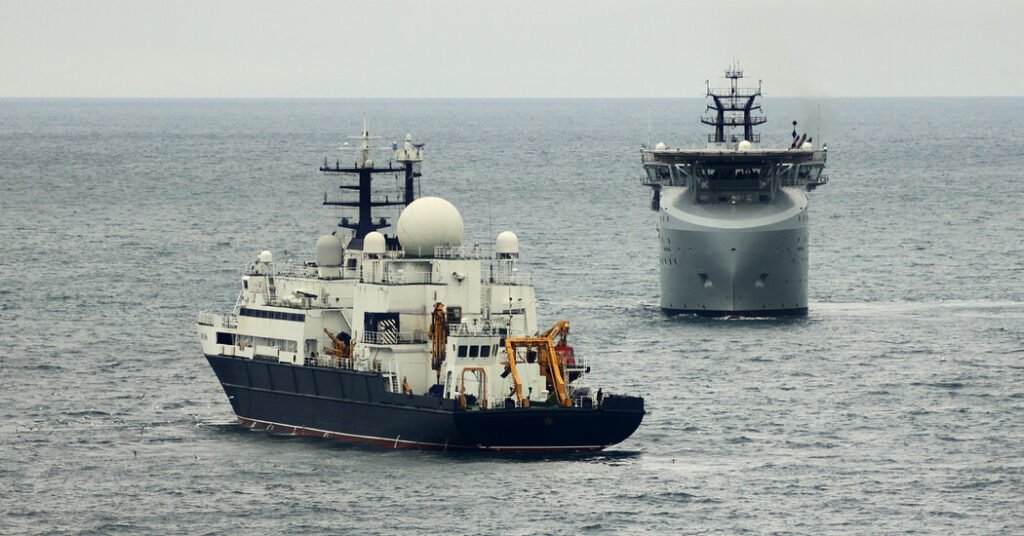Britain warned on Wednesday that it was facing a growing threat of Russian aggression, claiming that a Russian spy ship had passed British shores for the second time in three months in the latest incident designed to test Britain’s military capabilities.
British Defense Secretary John Healey told Parliament that two Royal Navy ships had been deployed for two days to monitor the passage of the Yantar, which he described as a Russian spy ship used to gather intelligence and map Britain’s critical underwater infrastructure.
The incident is the latest in a series of attacks by Russian ships and aircraft around Britain and comes amid growing concern about threats to critical infrastructure and possible sabotage in Europe, and Western intelligence agencies have warned of the Kremlin’s intention to punish Europe for its support for Ukraine. When the Yantar was first spotted in British waters last year, a British submarine was watching it nearby, the defense minister revealed on Wednesday.
While authorities have linked Russian intelligence services to vandalism, arson and attacks across Europe in recent years, threats at sea have caused the most concern and prompted the boldest responses. Last week, NATO announced it was deploying warships, patrol planes and drones to protect critical infrastructure in the Baltic Sea, apparently after several underwater cables were cut by ships dragging their anchors on the seabed.
Suspicion has arisen in European Union ships and ships with connections to Russia and China Covers a Chinese flag ship weeks and Finland seized the oil tanker may be part of Russia’s efforts to evade Western sanctions, according to experts and officials.
Russian Navy ships have carried out missions near Britain and elsewhere for years. But Mr Healey on Wednesday gave an unusual insight into the usually shadowy world of military surveillance and highlighted growing concerns about Russian activity, particularly around crucial undersea cables linking Britain to continental Europe.
“Russia remains the most pressing and immediate threat to Britain,” Mr Healey said on Wednesday, saying he wanted to send a message to Russian President Vladimir Putin. “‘We see you. We know what you are doing. And we will not hesitate to take strong action to protect this country.'”
Mr Healey also told MPs he had changed naval engagement rules to allow the two British ships to approach and track the movements of the Yantar, which has since sailed into Dutch waters.
Last November, Yantar was observed cruising over critical British undersea infrastructure, Mr. Healey said, adding that on that occasion he allowed a Royal Navy submarine to surface near Yantar to demonstrate surveillance.
At that time, the British said that “Yantar” was escorted by the frigate “Admiral Golovko” and the auxiliary tanker “Vyazma” before the ships left for the Mediterranean Sea.
The Yantar, which has been in service for about a decade, is a high-end spy ship designed by Russia’s General Directorate for Deep Sea Research specifically to hunt for critical undersea cables, said Justin Crump, CEO of the private intelligence company. , Sibylline, who has been watching the ship for years. According to him, the ship is equipped with two autonomous submarines that can operate in a large and largely undetected manner.
Mr. Crump said that while the Yantar could engage in sabotage, the ship was more likely to be used to locate and possibly tap cables for intelligence gathering and possibly map their locations for future operations.
“They spent a lot of time and money developing these ships, which have very impressive capabilities in this area,” he said. “And they actually realized that they could anchor to the bottom of the sea to break pipelines or cables.”
Although intelligence agencies and experts say the cutting of submarine cables fits the Kremlin’s covert playbook, evidence linking Russia to the latest episodes has actually been difficult to uncover. The Kremlin has denied its involvement in the provocation.
Finnish authorities on Wednesday announced that a preliminary investigation into the cutting of several critical undersea cables last month was nearing completion, but said it was too soon to say whether any country was behind it. Investigators have concluded that the captured oil tanker, the Eagle S, left a Russian port shortly before the cables were cut and dragged its anchor 100 kilometers down the seabed, which experts say is unlikely to have happened by accident. .
Shipping experts have determined that the Eagle S belongs to Russia’s so-called shadow fleet, a group of old tankers used to secretly transport crude around the world to fuel Moscow’s war machine in Ukraine. The tanker and its crew are under the control of Finland.
According to experts, Russia has long been interested in the West’s underwater cable network. Over the past few years, Russian naval and merchant ships have spent time off the coast of Ireland, where submarine cable bundles connect Europe and North America.
“We don’t know why they’re doing it,” said Elisabeth Braw, senior fellow at the Atlantic Council, which investigates Russian naval activity.
“They’re just pointing out that we can sit on submarine cables as long as we want and you can’t do anything about it?” – he asked. “Are they scouting for future actions that they might want to see or are they conducting some kind of hostile activity?”?
According to Ms. Brown, there is little that countries can do about it because international maritime law does not prevent Russian ships from operating in these areas.
Alistair Carmichael, a British MP who represents the Orkney and Shetland Islands, said that “Yantar’s activities could be escalating.” But he added that he had been warning Russian ships operating around the Shetland Islands, north of mainland Scotland, for nearly two years.
“This is a strategic threat to the UK as a whole, but it is particularly acute for our island communities who use cables for digital and energy connectivity,” he said.
Britain has been one of Ukraine’s most vocal backers since Russia invaded Ukraine in 2022, and tensions between London and Moscow have risen since Ukraine opened fire last year. British Storm Shadow missiles To the Kursk region of Russia.
Ken McCallum, the head of MI5, Britain’s domestic security service, amid heightened tensions last October Russian intelligence agents said He was on a mission to “create chaos on the streets of Britain and Europe”. He accused Russia’s military intelligence agency of “increasingly reckless and dangerous actions,” including “arson, sabotage, etc.” accused in cases.
In April, British prosecutors charged five men with working on behalf of Russia to arson businesses in Britain linked to Ukraine. And last fall, officials said fires at shipping facilities in Britain and Germany were likely caused by incendiary devices planted by Russian operatives.
Britain has recently reported more open military operations by Russia. Last September, he said British Typhoon jets scrambled to intercept two Russian Bear-F aircraft operating near British airspace. He also said that the British Navy shadowed four Russian ships, including a Kilo-class submarine, through the English Channel and the North Sea.
Johanna Lemola Prepared a report from Helsinki.

